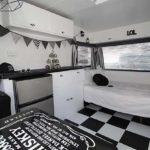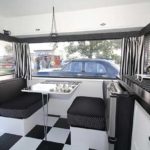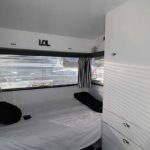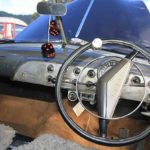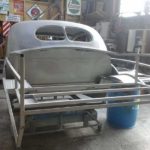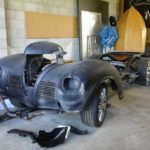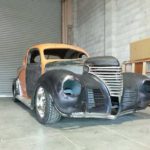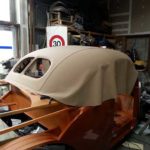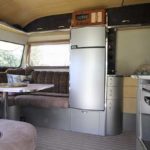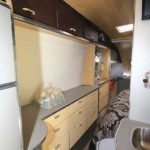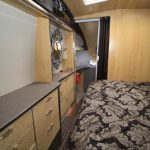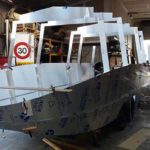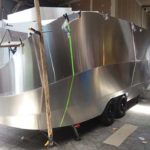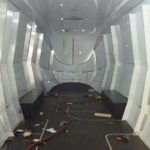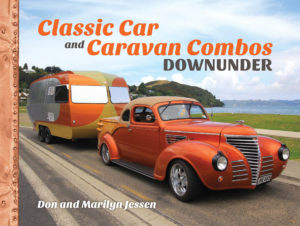Classic car and caravan combos in New Zealand

Three eye-catching New Zealand classic cars and matching caravans.
Words and Images: Don and Marilyn Jessen
In their new book Classic Car and Caravan Combos Downunder, Don and Marilyn Jessen profile a selection of the prettiest classic car and caravan combos across Australia and New Zealand. They talk to the owners about their twin passions and many of them share the restoration and acquisition stories that have led to them owning their car and caravan combo.
Don says, “When caravans were built in the old days, it was not uncommon for the new owners to request that the colour of their caravan be matched to their car. I can still remember seeing these stunning combos on the road when I was a lad. It is very cool to see vintage vanners doing the same thing now and colour matching their rigs.”
Kerry & Roni: 1941 Ford pickup with a 1954 Airstream Flying Cloud
This Airstream caravan is spectacular and won the 2018 Beach Hop best caravan award. The 1941 Ford pickup is also very cool and certainly looks the part in front of the Airstream. But Kerry can be quite particular, so he has recently bought a right-hand-drive 1959 Ford Country Sedan to take over towing duties. Why? Because it is more period correct and being right hook means that it will be easier to tow with. The ’59 is currently having an engine, transmission and brake renewal, but even when that’s done, Kerry and Roni plan to keep the Ford pickup.
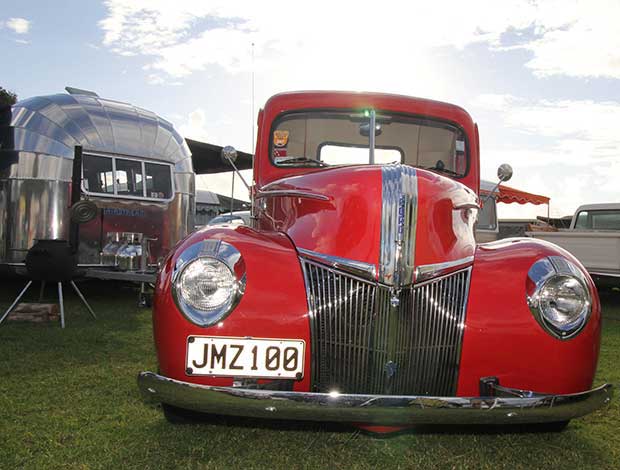
So, what was involved with this car and caravan? Kerry and Roni have owned the Ford pickup for about four years. They saw it advertised for sale in Indianapolis in the United States, and — having heard other people’s horror stories about buying vehicles sight unseen — Kerry was quick to travel there for a pre-purchase inspection.
The Ford has a Mustang II independent front suspension with disc brakes, and it is powered by a 350-cubic-inch Chevrolet motor with a Turbo 350 Transmission coupled to a nine-inch differential. Resplendent in red livery, the Ford is set off with wide whitewalls on steel wheels. The rims wear hubcaps and stainless beauty rings. The top sides of the tray have varnished American oak timber rails running along their length. The attention to detail is very high and this extends to the presentation of the engine bay.
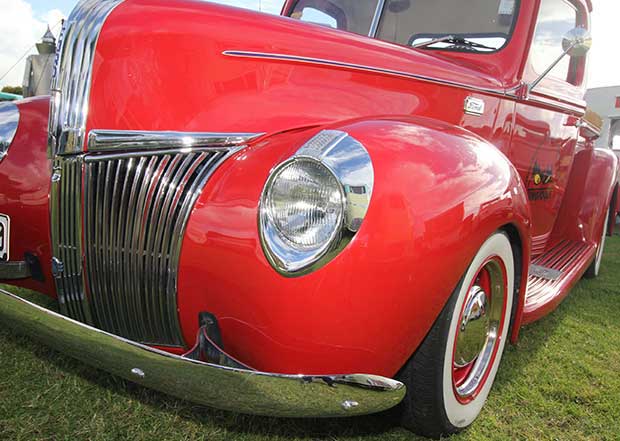
The interior is upholstered in cream vinyl with red cording surrounding fluted cream insets on the seats, door cards and hood lining. This is a very pretty Ford pickup and Kerry and Roni have kept a traditional look to it. Kerry is a member of the hot rod club Southside Streeters, based in the Auckland suburb of Howick.
Old Airstreams are such handsome caravans. In the United States, they have reached an iconic status and when one looks at the bodywork it is easy to see why. In particular, the pre-1958 models with their 13 aluminium panels that make up the rounded ends are extremely sought after. Kerry and Roni sourced this Airstream out of Kansas. It is a 1954 Flying Cloud model made in Ohio. Following its arrival in New Zealand, they quickly stripped the interior bare to find the floor and chassis in need of replacement.
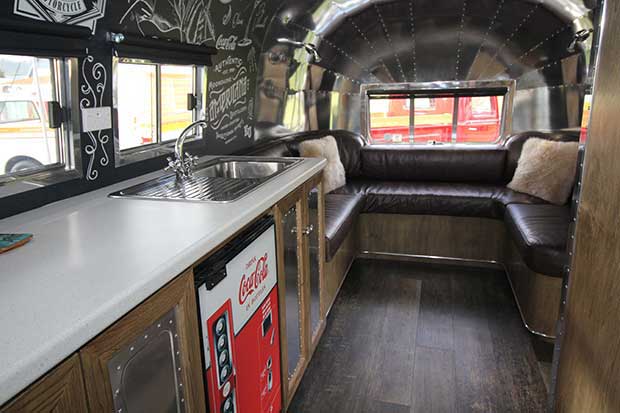
Kerry said they knew that 80 per cent of the exterior panels were in good condition, but had hoped the chassis would have been in better shape. They separated the body from the chassis, pushed that into a paddock and then proceeded to build a new chassis that was 40 per cent stronger than the original. They did this to take the stress out of the riveted aluminium body, which is prone to leaking through the rivets as they come under stress whilst travelling on a lighter chassis.
Once the body had been reattached and new windows were installed, they started on the interior. And what a job they have done!

Not only did they rebuild it, but they have turned it into something very special. As the caravan was sourced from Kansas, they worked with a Wizard of Oz theme, calling the caravan Dorothy, and even making a Tin Man holding a little sign featuring this Airstream’s story as an awning ornament.
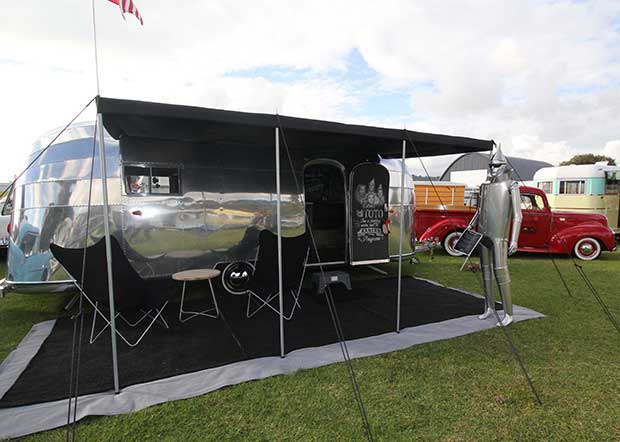
The ceiling has been lined over the aluminium inner skin with a black and white chalkboard graphic featuring iconic signs, sayings and personalities from 1950s America. It is just spectacular. The ends of the ceilings have been left in polished aluminium and feature the fantastic Airstream panelling. The furniture is built using American ash, which is finished with a tea-coloured stain. Pressed and polished aluminium door insets complete with solid rivets and a small polished aluminium bead rail breaks the timber toe recess from the floor.

The rear of the caravan features a permanent double bed with the sink bench running forward on one side and a large bathroom featured on the other side. The bathroom has large, curved, polished aluminium corner moulds for its exterior corners, which are actually aluminium extrusions used for heavy transport trailers.
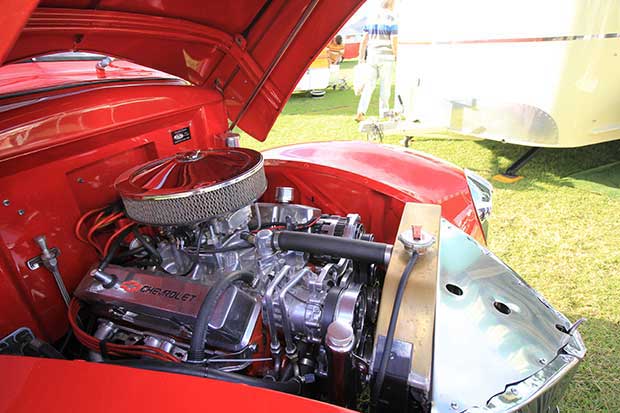
The shower door has a light frosted-glass insert with polished aluminium surround. The beautiful period taps in the shower match the sink taps. Opposite it, under the sink, is the fridge, which has a door face that looks exactly like a 1950s Coca-Cola dispensing machine. Forward of the bathroom on the right-hand side is the exterior door. The front is taken up with U-shaped lounge seating with dark brown distressed leather squabs, which can seat seven at a squeeze.

Faced with a full rebuild over 18 months and a plan for an interior that didn’t waver, Kerry and Roni came up with a spectacular vision and, boy, have they delivered.
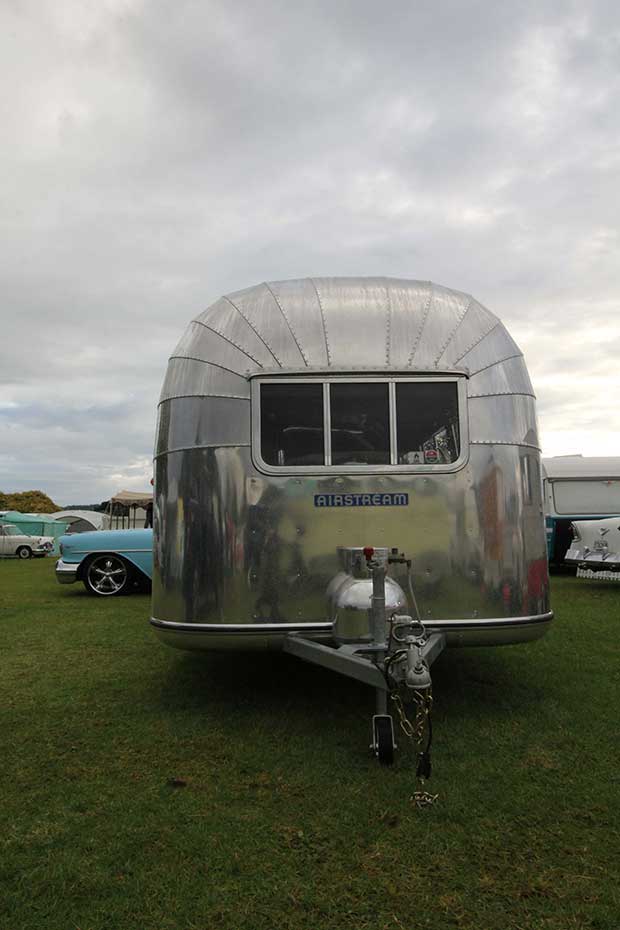
Shane & Maree: 1951 Ford Twin Spinner V8 with a 1976 Clansman
Shane is no stranger to old cars, having owned a 1939 Ford and a 1947 Studebaker before purchasing this 1951 Ford V8 in 2017. The caravan was bought at around the same time and received a makeover to match the car.
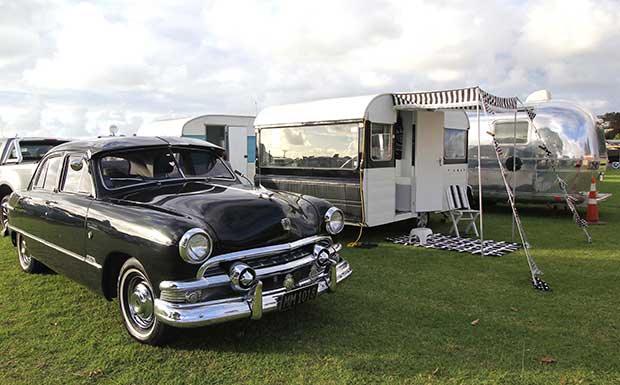
This 1951 Ford Twin Spinner V8 is original, still powered by its old 239-cubic-inch V8 flathead motor. These cars were considered rather flash in their day and are quite sought after by collectors in New Zealand. The black paintwork looks really smart and the interior is very tidy. There is no doubt that Shane loves his Ford and he reports that it tows the caravan amazingly well. Amongst the modified cars, it is really cool to see original ones still doing towing duty as many of them did in their heyday.
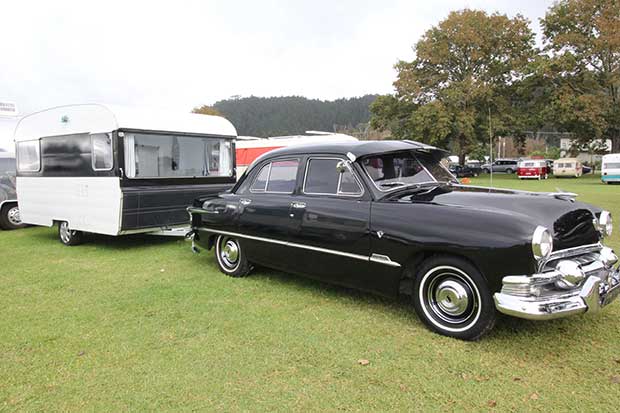
Clansman caravans were not made in huge numbers, so it is really nice to see a small number of them being restored and turning up at retro caravan rallies. This one is a 1976 model, which Shane and Maree have restored with a retro Jack Daniel’s theme. The exterior has been repainted in white with a black insert panel to match the Ford. The black and white striped porch awning, spotted bunting and black-and-white checked awning floor complete the eye-catching exterior.

Inside the Clansman, the same black and white theme has been carried throughout. The linings and furniture are finished in white with a black Formica bench top, and the dining table (also in black and white) sports a Jack Daniel’s Tennessee whiskey label. A black and silver fridge/freezer has been fitted, and black squabs with white star edges create a simple elegant look to the caravan. The white star effect is carried through to the pelmets, which are complemented with black and white vertical-striped curtains. The vinyl floor is in black and white diner-style chequerboard.
The whole effect is very tasteful, and the car and caravan make a lovely combo.
Wal & Mel: 1939 DeSoto coupe pickup with a 2017 Retro Homebuilt
Don’s first sighting of this beautiful outfit stopped him in his tracks. It was at the Stragglers Cambridge Charity Car Show at Lake Karapiro in the Waikato. Don was putting our latest vintage van, Daisy Mae, on display for the first time when he spotted this combo. That day, he managed to have a quick chat to owners Grant (also known as Wal) and Mel.

The van was spectacular and the car had Don drooling. As the day went on and he talked to show-goers, he started to think about this great outfit and then his mind wandered to other car and caravan combinations he had come across. By the time he got home, the idea for this book had germinated in his head, the inspiration for which was this outfit.
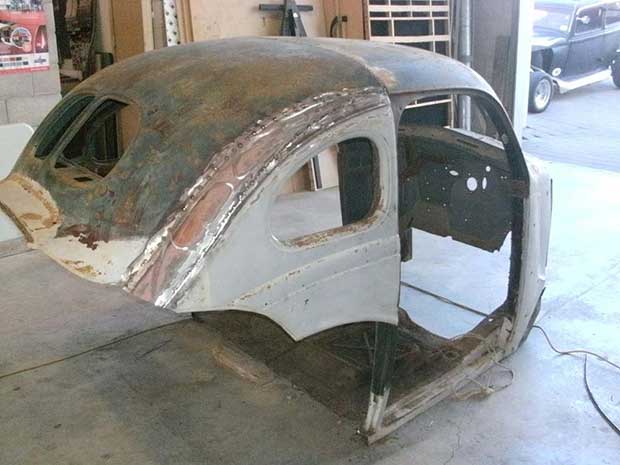
Over Christmas that same year, Don spied Wal’s car in our hometown of Whitianga and tracked the couple down at Simpsons Beach, just a few minutes north of Whitianga.
Don got there just in time, as Mel was down at the local market selling her paintings and outdoor art and when that finished they were planning to head home to Lake Taupo. Before they left, Wal happily shared the story of their delightful combo.
The car appears to be a 1939 DeSoto coupe pickup, if there ever was such a thing. This car had sat on the lawn as a piece of garden art for 15 or so years. It was a four-door sedan and looked a little forlorn. In the end Mel said, ‘It’s got to go!’ That got Wal thinking. He had built a few hot rods in the past and, at the time, he had a rat rod in the shed. Why not turn the DeSoto into a rod? So he set about doing just that. The sedan was chopped down and turned into a coupe. A 1975 Holden ute chassis was used as a base and narrowed to fit the body shell. A 2003 Commodore rear end was fitted, with Commodore suspension and disc brakes all around. The Chevrolet 350-cubic-inch V8 engine came out of a Holden Caprice and was mated to a 400 transmission.

The body required new sheet metal for the firewall and other areas underneath. Wal decided to make the new coupe into a coupe pickup, so built the full body tray in timber and varnished it, virtually turning it into a woody. Electric windows were fitted. In the front went Commodore bucket seats and a typical club coupe back seat was fitted as well. Wal also spotted a 1937 Plymouth dashboard and was really taken with it, mainly because it had a really cool clock. He acquired the dashboard and extended it to fit. The metal part of the coupe was painted in a really cool shade of metallic orange, which is set off with a light fawn/beige vinyl roof.
The colour scheme combined with the woody back-end and the old-school mags make the DeSoto look just stunning. Wal had decided he wouldn’t mind a retro caravan, but his goal was to build one from scratch to his own retro design. He started playing around drawing up caravan shapes then showed them to a boatbuilder mate. He told Wal that his plans needed to be a lot more accurate. His mate had a CAD program on his computer, so they sat down together and designed the caravan using that. Now serious about his new project, Wal sold his rat rod to finance the caravan.

The CAD designs were sent to a company who used them to laser cut all the exterior panels for the new caravan. When they arrived at Wal’s place on a pallet, he reckoned it was just like having a giant 3D jigsaw puzzle to put together. Once completed, the shell was mounted on a tandem-axle, electric-braked chassis that Wal had built. The body length is 6.4 metres. The body shell was partially vinyl wrapped in an orange-and-woodgrain effect to match the DeSoto, and the exterior shape and colour of the caravan is outstanding. To us it has a sort of Back to the Future, slightly steam punk, futuristic retro Airstream look to it. If you can get your head around that, you will know that we think this is one beautifully shaped caravan.
The complex curved shape of the body shell made the interior design, build and fit-out quite difficult because nothing was square. It was like custom-building the interior of a launch or yacht. Mel became involved in sourcing retro fittings and hardware, and she oversaw the interior décor.
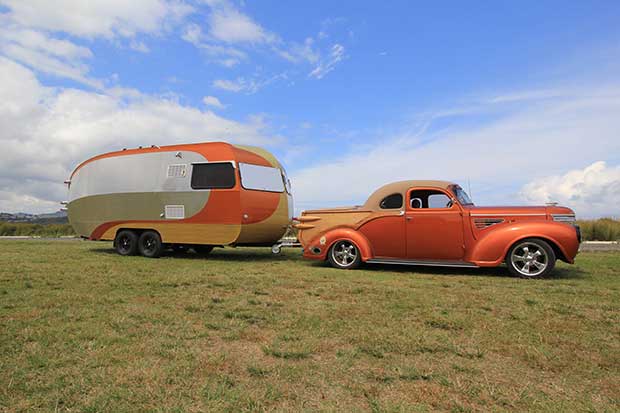
The interior design is quite lovely with a semi-circular lounge up front with a swivel table in the centre. Opposite the main door is a large three-way fridge/freezer with a beautifully built 1930s mahogany radio mounted on top. The radio has been modified to play using Bluetooth and USB. On either side are overhead cupboards covered in alligator-skin-style vinyl. A sink bench runs across the caravan from the door, with a full floor-to-ceiling partition behind it. From there, a double bed runs lengthwise with a long lowboy opposite. To the rear, following the deeply curved back end of the caravan, is an elegant bathroom fitted with shower, toilet and a large vanity unit.
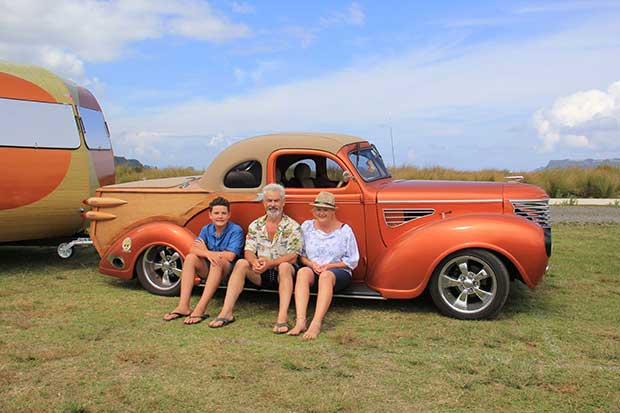
Being an upholsterer by trade, Wal has made great use of innovative materials in the interior, and with carefully resourced hardware, the caravan has a beautiful retro feel and appearance. The caravan is also fitted out with solar power, a gas electric heater and a secondary gas blower. The electrical system can also cater for charging devices and has an inverter. The caravan also has a television. A sliding pull-out barbecue has been fitted along with a roll-out awning roof and a fold-down table to the back of the exterior door. To complete the picture, Wal fitted water and waste tanks and gained a self-containment certificate, so they can take the caravan off road and into New Zealand Motor Caravan Association (NZMCA) camps.
This caravan has been incredibly well thought out in terms of Wal and Mel’s needs and the way they wish to use it. Not too shabby for first-time caravanners and builders. Wal built the caravan in blocks of time. He would work overtime in his business for several weeks, then take three weeks off and work solidly on the caravan, then repeat the process. He initially tried working weekends only, but found that by the time he got his head in the right place, half the day was gone. We quite agree with him. When building you need to be in the right headspace, not trying to figure out what you did last weekend and what you need to accomplish over the current weekend.
The matched caravan and DeSoto just look amazing together, and we know from the time we spent with Wal, Mel and their youngest son William, that it just draws people to it. So, with all that, how does the outfit travel? Wal says that it sits comfortably at 80–90 kph, but at anything above that he can feel the van starting to move around a little bit. That could be the Commodore independent suspension on the DeSoto contributing or it could be that 80–90kph is the van’s sweet spot. It could even be the loading of the caravan. Balance can be easily upset if you pack more to the rear than the front. Either way, it is not an issue as the speed limit in New Zealand for towing caravans and trailers is 90kph.
Available at Paper Plus and Take Note stores.
RRP: $39.99
